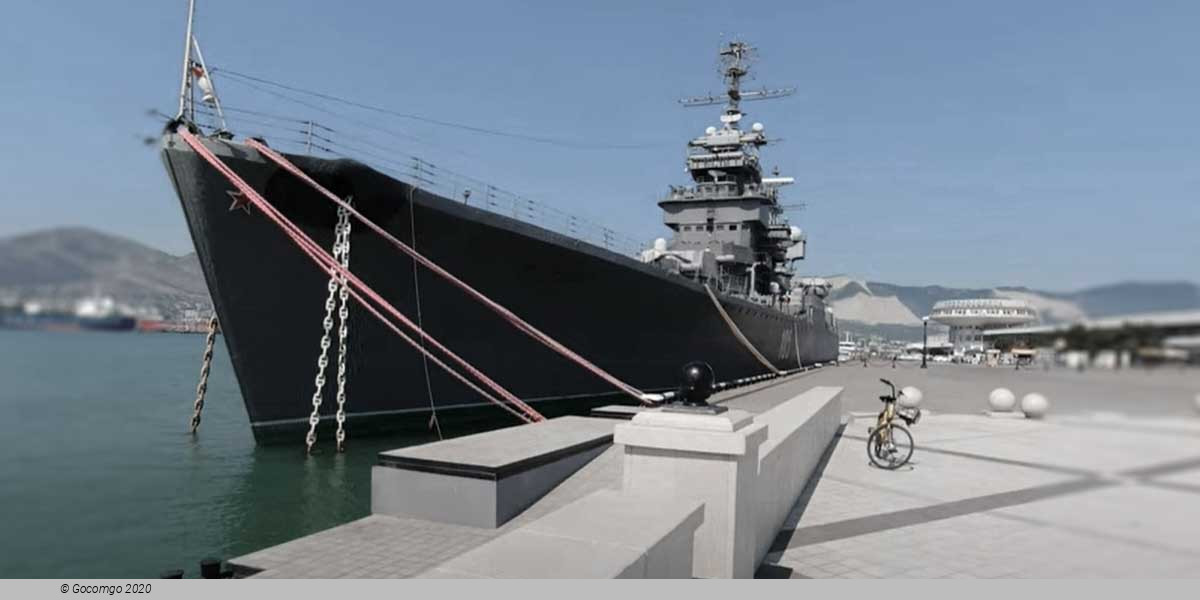Novorossiysk

Novorossiysk is a city in Krasnodar Krai, Russia. It is the largest port on the Black Sea and the largest Russian port. It is one of the few cities honored with the title of the Hero City.
History
In antiquity, the shores of the Tsemes Bay were the site of Bata, an ancient Greek colony that specialized in the grain trade. It is mentioned in the works of Strabo and Ptolemy, among others.
Following brief periods of Roman and Khazar control, from the 9th century onwards, the area was part of the Byzantine θέμα Χερσῶνος Thema Khersonos (Province of Cherson).
During the 11th century, the area was overrun and controlled by nomads from the Eurasian steppe, led by the Cumans. Later that century, the Byzantine emperor Ἀλέξιος Κομνηνός Alexios I Komnenos (r. 1081–1118) was approached by Anglo-Saxon refugees, who had left England following the Norman conquest. Alexios offered land to these refugees in Thema Khersonos if they could recapture it from the nomads and there is contemporaneous evidence that a Byzantine-English colony was subsequently founded. For example, medieval nautical charts mention place names on the Kuban coast with possible English origins, including a port (located within or near the future site of Novorossiysk) known as Susaco (or Susacho) – a name that may have been derived from Sussex. (The same maps also show, north-west of Susaco, a river Londia, which may derive its name from London.)
In the 15th century, Genoese merchants from the Ghisolfi family maintained a trade outpost in the area. Archaeological investigation of related sites is in its infancy, but some interesting items have already been uncovered.
From 1722, the bay was controlled by an Ottoman fortress (qale) named Sujuk (also transliterated Sudzhuk, Sudschuk and Soğucak). This name may be derived from Susaco (see above) and, as late as 1769, the area was sometimes named in European maps as Suzako.
The coastline was ceded to Russia in 1829 as a result of the Russo-Turkish War. After this, admirals Mikhail Lazarev and Nikolay Raevsky founded an eastern base for the Black Sea Fleet on the shore in 1838. Named after the province of Novorossiya, the port formed a vital link in the chain of forts known as the Black Sea Coastal Line, which stretched south to Sochi.
During the rest of the 19th century, Novorossiysk developed rapidly. It was granted city status in 1866 and became the capital of the Black Sea Governorate, the smallest in the Russian Empire, in 1896. In December 1905, the city was the seat of the short-lived Novorossiysk Republic. From August 26, 1918, until March 27, 1920, Novorossiysk was the principal center of Denikin's White Army. Denikin's South Russian Government was moved to Crimea and many Whites escaped from Novorossiysk to Constantinople during the Evacuation of Novorossiysk (1920).
Most of the town was occupied by the German and Romanian Armies on September 10, 1942. A small unit of Soviet sailors defended one part of the town, known as Malaya Zemlya, for 225 days beginning on February 4, 1943, and the town was liberated by the Red Army on September 16, 1943. The heroic defense of the port by the sailors allowed the Soviets to retain possession of the city's bay, which prevented the Axis from using the port for supply shipments. Novorossiysk was awarded the title Hero City in 1973.
In 1960, the town was commemorated in Dmitri Shostakovich's work Novorossiysk Chimes, the Flame of Eternal Glory (Opus 111b).
In 2003, President Vladimir Putin signed a decree setting up a naval base for the Black Sea Fleet in Novorossiysk. Russia has allocated 12.3 billion rubles (about $480 million) for the construction of the new base between 2007 and 2012. The construction of other facilities and infrastructure at the base, including units for coastal troops, aviation, and logistics, will continue beyond 2012.
The Russian lease on port facilities in Sevastopol, which, though the main base of Russia's Black Sea Fleet, is part of Ukraine, was set to expire in 2017. Ukraine was reported to be planning to not renew the lease; however, in April 2010 the Russian and Ukrainian presidents signed an agreement to extend the lease by twenty-five years, with an option of further extension of five years after the new term expires. However, in 2014, Crimea was annexed by the Russian Federation during the 2014 Crimean crisis and as such, the question of renewing the lease does not immediately arise while Crimea remains de facto part of the territory of the Russian Federation.

